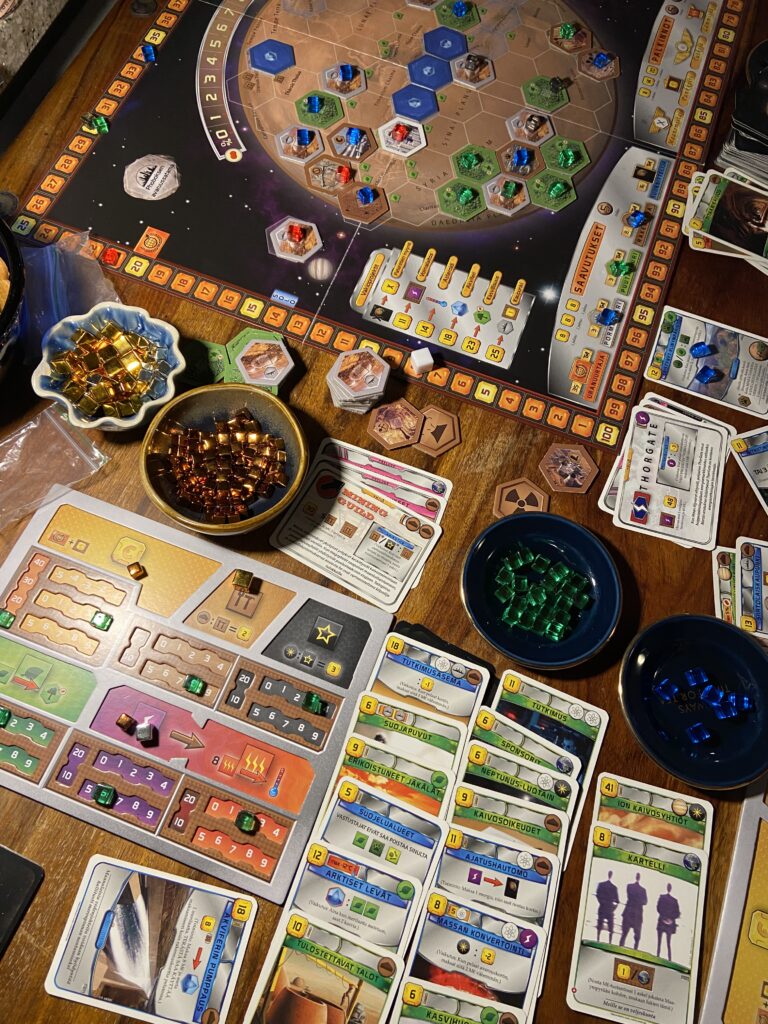This is a series of posts where I play 100 boardgames.

Game: Terraforming Mars
Expansion: Prelude
Designer: Jacob Fryxelius
Year: 2016/2018
Country: Sweden
Publisher: FryxGames
I was coming home from the library recently, with a couple of different boardgames I was intending to try for this study project. The culture at our apartment building is extremely taciturn but seeing Terraforming Mars in my bag prompted one of my neighbors to comment on how excellent it was. When I finally did end up playing it yesterday, it was not with the library copy but arranged by a friend who knew the game. She said that among Terraforming Mars veterans, it’s customary to use the Prelude expansion because it speeds up an otherwise sedate early game.
And indeed, pacing felt like the most striking feature of Terraforming Mars. Play proceeds in generations of terraformers where you take turns performing actions until you’re out of playable cards and resources. Then you move to the next generation, gaining more of everything so that you can make more actions. In the early game even playing with Prelude, I was worried the game was going to take all night because the three progress indicators, temperature, number of sea tiles on the board and atmospheric oxygen, moved at a glacial pace.
Terraforming Mars is a competitive boardgame in which various corporations seek to collectively make Mars livable for humans. There’s a cooperative aspect to it because the game won’t progress unless players also make moves that potentially benefit others. For example, I had cards which could only be used when the temperature reached -6 degrees Celsius. The contributions of my co-players got me there.
The pacing moved at an exponential scale, so that while the early going was slow and steady, the late game was a mad rush for victory. Suddenly the temperature was going up and the planet was being filled with water in a mad rush for the finishing line. I used a card to blow up a nuclear device to heat up the planet quickly because I wanted to keep another player from gaining valuable victory points from raising the temperature.
The game follows a typical design pattern in that the basic mechanism of play is simple and fast to learn and complexity is added in cards that you draw into your hand. While other players are taking their turn, you can read your cards and figure out what they do. This way, the game can feature significant complexity without forcing all players to learn how everything works. You only need to understand the cards you’re using.
Similar to Ark Nova, the early setup is simple with just your player board and a few cards, but after a few generations you have a huge spread of played cards in front of you, all with their own effects and opportunities.
In terms of theme, Terraforming Mars felt very well thought-out, but that has been the norm for all of the games I’ve played during this project so far. The idea of making a planet habitable felt very tangible in the game’s core actions, and jibed with the cursory understanding I have of the topic from reading Kim Stanley Robinson’s Mars trilogy. We liked the modest satirical element, not too forceful so as to detract from the hard scifi aesthetic but still there to provide a bit of humor.
The version of the game we played was the Finnish translation from Lautapelit.fi. That makes it the first Finnish-language game I’ve played during this project.